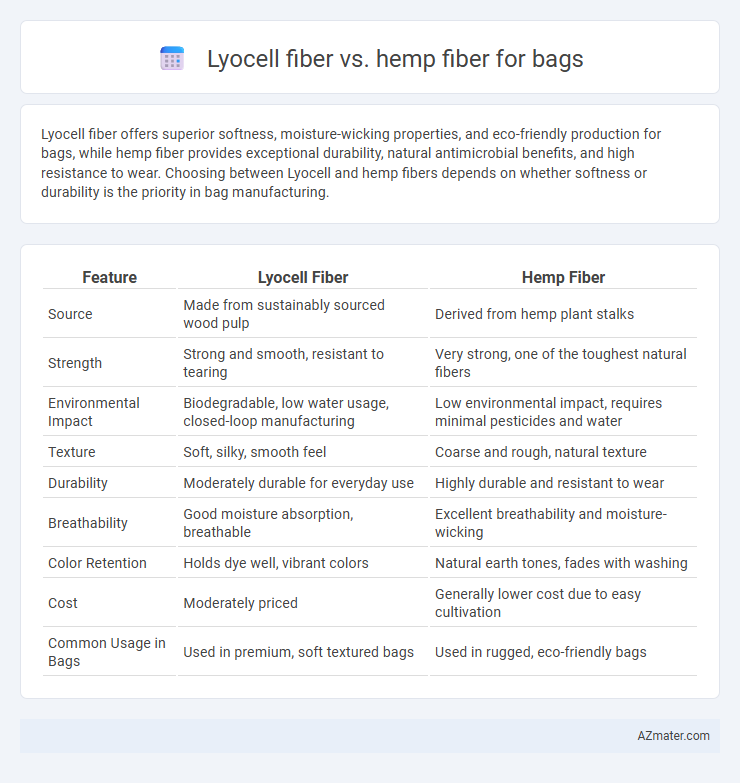Lyocell fiber offers superior softness, moisture-wicking properties, and eco-friendly production for bags, while hemp fiber provides exceptional durability, natural antimicrobial benefits, and high resistance to wear. Choosing between Lyocell and hemp fibers depends on whether softness or durability is the priority in bag manufacturing.
Table of Comparison
| Feature | Lyocell Fiber | Hemp Fiber |
|---|---|---|
| Source | Made from sustainably sourced wood pulp | Derived from hemp plant stalks |
| Strength | Strong and smooth, resistant to tearing | Very strong, one of the toughest natural fibers |
| Environmental Impact | Biodegradable, low water usage, closed-loop manufacturing | Low environmental impact, requires minimal pesticides and water |
| Texture | Soft, silky, smooth feel | Coarse and rough, natural texture |
| Durability | Moderately durable for everyday use | Highly durable and resistant to wear |
| Breathability | Good moisture absorption, breathable | Excellent breathability and moisture-wicking |
| Color Retention | Holds dye well, vibrant colors | Natural earth tones, fades with washing |
| Cost | Moderately priced | Generally lower cost due to easy cultivation |
| Common Usage in Bags | Used in premium, soft textured bags | Used in rugged, eco-friendly bags |
Introduction to Lyocell and Hemp Fibers
Lyocell fiber, derived from sustainably sourced wood pulp, is known for its smooth texture, biodegradability, and high tensile strength, making it an eco-friendly choice for durable bags. Hemp fiber, harvested from the stalks of the hemp plant, offers exceptional toughness, resistance to UV light, and natural antimicrobial properties, which contribute to long-lasting and sustainable bag production. Both fibers promote environmental sustainability by reducing reliance on synthetic materials and minimizing chemical processing in bag manufacturing.
Sustainability Comparison: Lyocell vs Hemp
Lyocell fiber, produced from sustainably harvested eucalyptus wood using a closed-loop solvent process, offers high tensile strength and biodegradability, making it an eco-friendly option for bags. Hemp fiber is a highly renewable resource requiring minimal water, pesticides, and land, with exceptional durability and natural resistance to mold and UV light, contributing to a lower environmental footprint compared to conventional fibers. Both fibers feature biodegradability and reduced chemical usage, but hemp's minimal agricultural inputs and faster growth cycle position it as a superior sustainable choice for bag manufacturing.
Raw Material Sources and Processing
Lyocell fiber is derived from sustainably managed eucalyptus trees using a closed-loop solvent spinning process that recycles water and solvents, minimizing environmental impact. Hemp fiber originates from the stalks of the Cannabis sativa plant, processed through retting and decortication, which requires less water and pesticides compared to conventional cotton. The chemical-intensive processing of lyocell contrasts with hemp's more mechanical extraction methods, making hemp fibers more natural but lyocell fibers softer and more uniform for bag production.
Environmental Impact of Each Fiber
Lyocell fiber is produced using a closed-loop process that recycles water and solvents, significantly reducing pollution and environmental harm compared to traditional rayon. Hemp fiber is highly sustainable due to its rapid growth, minimal pesticide requirements, and its ability to improve soil health through phytoremediation. Both fibers offer eco-friendly alternatives for bag production, with Lyocell focusing on low chemical waste and Hemp emphasizing renewable cultivation.
Durability and Strength in Bag Applications
Lyocell fiber offers high tensile strength and excellent abrasion resistance, making it suitable for durable bags that withstand daily wear and tear. Hemp fiber is renowned for its superior tensile strength and natural resistance to stretching, providing robustness and longevity in heavy-duty bag applications. Both fibers enhance bag durability, but hemp excels in strength for rougher, load-bearing uses, while lyocell contributes softness and flexibility.
Texture, Appearance, and Aesthetic Qualities
Lyocell fiber offers a smooth, silky texture with a subtle sheen that enhances the visual appeal of bags, creating a modern and refined aesthetic. Hemp fiber presents a coarse, rugged texture with a matte finish, giving bags a natural, earthy look favored for eco-friendly and rustic designs. Both fibers provide durability, but Lyocell emphasizes softness and elegance, while hemp highlights sustainability and raw texture in bag manufacturing.
Comfort and Breathability Factors
Lyocell fiber offers superior softness and moisture-wicking properties, making it highly comfortable and breathable for bags used in warm weather. Hemp fiber, while durable and eco-friendly, is coarser but improves breathability through its natural structure, which promotes airflow and reduces heat buildup. Combining lyocell's smooth texture with hemp's ventilation qualities provides an optimal balance of comfort and breathability in bag materials.
Cost Analysis: Lyocell Bags vs Hemp Bags
Lyocell bags generally incur higher production costs due to the intensive chemical process and higher energy consumption involved in fiber extraction, whereas hemp bags benefit from lower raw material costs and minimal processing requirements. The durability and biodegradability of hemp fibers contribute to longer product lifespan, potentially lowering replacement frequency compared to lyocell bags. Market price analysis indicates that while lyocell bags often command premium retail prices for their softness and aesthetic appeal, hemp bags are favored in cost-sensitive segments due to their affordability and sustainability credentials.
Biodegradability and End-of-Life Disposal
Lyocell fiber offers excellent biodegradability, breaking down naturally within weeks under composting conditions, making it highly sustainable for bag production. Hemp fiber also exhibits strong biodegradability, decomposing efficiently in soil without releasing toxic residues, and benefits from being recyclable and compostable at the end of its lifecycle. Choosing between Lyocell and Hemp for bags depends on specific sustainability goals, but both fibers support eco-friendly end-of-life disposal through natural degradation and minimal environmental impact.
Market Trends and Consumer Preferences
Lyocell fiber is gaining traction in the bag market due to its sustainable production process and soft, durable texture, appealing to eco-conscious consumers seeking premium quality. Hemp fiber remains popular for its natural strength, biodegradability, and rustic aesthetic, attracting buyers focused on durability and environmental impact. Market trends indicate a growing blend of Lyocell and hemp fibers in bags, combining softness with toughness to meet diverse consumer preferences for sustainable and stylish accessories.

Infographic: Lyocell fiber vs Hemp fiber for Bag
 azmater.com
azmater.com